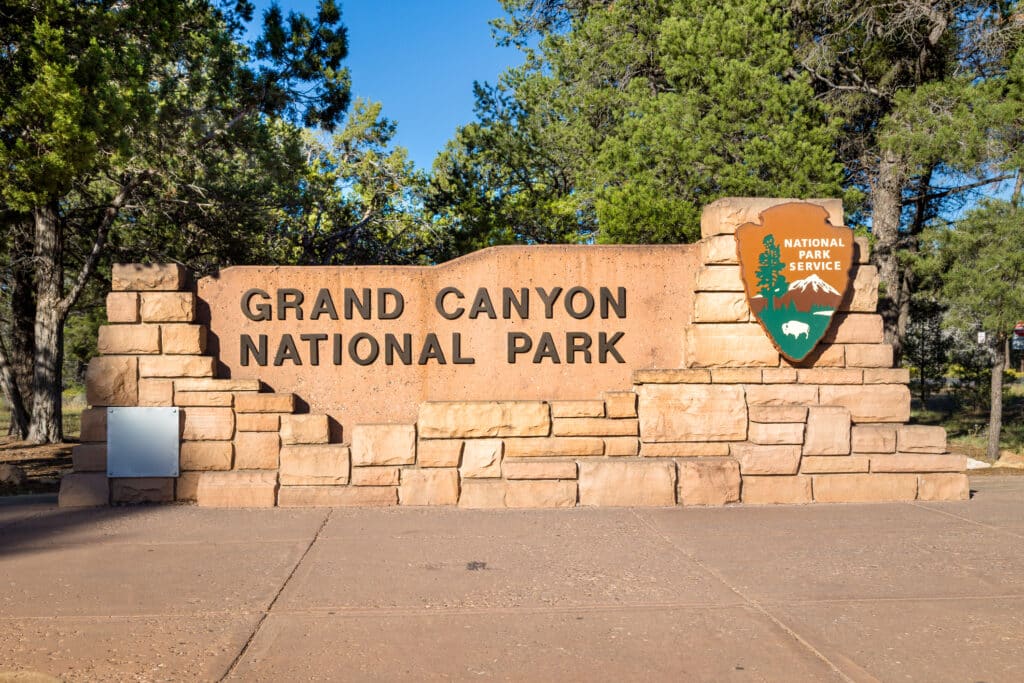
Grand Canyon National Park currently charges an entrance fee of $35 per private vehicle (valid for 7 days for all occupants). If you arrive on foot, bicycle, or shuttle, the per-person fee is $20, and motorcyclists pay $30 for a 7-day pass. All passes cover both the South Rim and North Rim of the park during their open seasons.
There’s also a $70 Grand Canyon Annual Pass for unlimited visits in a year, and the $80 America the Beautiful interagency pass which covers this and other U.S. national parks. Children 15 and under enter free, which is great for families. In addition, U.S. 4th grade students, active-duty military, and military veterans can obtain free national park passes, and seniors over 62 can get discounted passes ($20 for an annual senior pass or $80 lifetime).
The park itself is open 24 hours a day. The South Rim is accessible year-round (even on holidays), while the higher-elevation North Rim closes in winter (its access roads shut from December 1 to May 14, so that side is generally open mid-May through mid-October). No gates lock at night on the South Rim, so you can catch sunrise or sunset whenever you please – we’ve even driven in at 5 am with no issue. Do note that entrance stations no longer accept cash (card only), though a few businesses in nearby Tusayan will sell passes for cash if needed. Also, during dry summer months, the park often enforces fire restrictions (when we visited, campfires were banned due to high wildfire risk, and only propane camp stoves were allowed). We visited on 20 July 2025, and all figures were valid then.
Comprehensive Guide to the Park
Have you ever stood on the edge of a chasm so vast that it makes you question your sense of scale? The Grand Canyon’s sheer immensity and beauty left us awe-struck from the moment we stepped to the rim at Mather Point. Stretching about 277 miles in length, up to 18 miles wide, and over a mile deep, this canyon is massive. Layer upon layer of red, orange, and purple rock extend as far as the eye can see, carved by the Colorado River over millions of years. Gazing down, we were literally looking at 2 billion years of Earth’s geologic history exposed in the canyon walls – ancient Vishnu Schist rocks form the dark base, topped by younger cliff-forming limestones and sandstones near the rim. It’s like Mother Nature decided to slice open a layer cake of time.
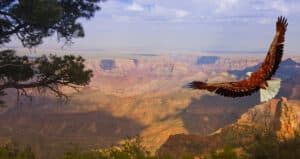
Eagle takes flight over Grand Canyon USA
Is it any wonder Grand Canyon is often called one of the “Seven Natural Wonders of the World”? We learned it became a protected national park in 1919 (and a UNESCO World Heritage Site in 1979) precisely because of how unique and valuable this landscape is. The result of all that protection? We get to enjoy an unspoiled vista that’s beyond compare – a living geology textbook mixed with unbelievable scenery.
Beyond the rocks, the park teems with life. During our hikes we transitioned through multiple ecosystems, from high elevation forests at the rim down to desert-like conditions near the river. The South Rim (at ~7,000 feet elevation) is dotted with ponderosa pines, pinyon pine and juniper trees, giving way to fragrant sagebrush and cliffrose on the slopes.
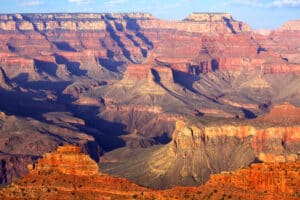
South Rim Grand Canyon before sunset, Arizona, US

In contrast, the North Rim (even higher at ~8,000 feet) has lush fir and aspen forests that feel almost Alpine in summer. As we descended into the canyon on Bright Angel Trail, we noticed the air warming and plants changing – junipers and prickly pear cacti started to appear on the sun-baked ledges. It’s kinda amazing: in a single day’s trek you can go from cool highlands to hot desert and see vegetation that resembles Colorado’s forests at the top and Arizona’s Sonoran Desert at the bottom. The Grand Canyon’s diversity blew our mind with how many distinct habitats fit into one giant gash in the Earth.
Wildlife was surprisingly abundant, especially in mornings and evenings. We woke up early and were rewarded with sightings of mule deer and elk grazing quietly in the meadows around Grand Canyon Village. Sneaking down a less-traveled path one dusk, we even spotted a big horn sheep picking its way along a steep cliff – it paused and stared at us for a few moments before deftly scampering down the rocks out of sight. Above us, enormous California condors occasionally soared on thermal winds; with wingspans of nearly 3 meters, they are truly a sight to behold. (These condors were reintroduced in the 1990s as part of a major conservation effort – a real success story, considering the species nearly went extinct.)
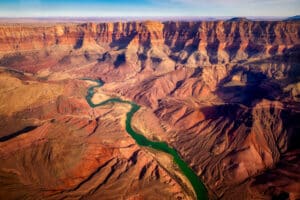
Grand canyon aerial view with Colorado river, USA.
We also encountered plenty of cheeky rock squirrels begging for snacks at popular overlooks – watch your lunch, because they’ll steal it right from under your nose if you’re not careful! From tiny whiptail lizards skittering over the rocks to ravens riding the canyon updrafts, the fauna added a dynamic energy to our visit. It felt like every time we turned a corner on the trail, there was something new – tracks of a ringtail cat in the dust, or the call of a canyon wren echoing off the walls with its descending whistle.
Of course, one of the best ways to experience the park’s wild side is by hitting the trails. The Grand Canyon offers everything from casual rim-top strolls to extreme backcountry treks. We hiked down part of the famous Bright Angel Trail, a historic path used by Indigenous peoples and early explorers, which starts near Bright Angel Lodge. The trail zigzags down through the colorful cliffs, offering ever-changing perspectives on the canyon.
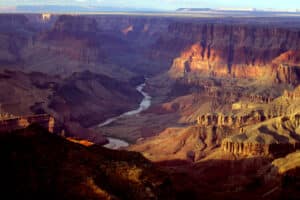
Grand Canyon National Park, Arizona.
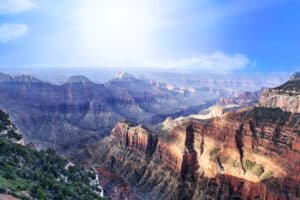
The Grand Canyon in Arizona USA. Looking from the north rim.
We made it as far as Indian Garden (a lush oasis about 4.5 miles down, where cottonwood trees and a trickling creek provided shade) before turning back – the hike back up was definitely tough (our calves were burning!), but so worth it. Another day, we tried the shorter South Kaibab Trail up to Ooh Aah Point, which, true to its name, made us literally say “oooh!” and “aah!” at the sweeping view of the canyon and the river far below. There’s countless trails to choose from, and each reveals a different facet of the canyon. Even simply walking along the Rim Trail (an easy, mostly flat path that connects many overlooks on the South Rim) gave us incredible panoramic vistas without much effort. We often set off just after sunrise, when the air was crisp and the trail was quiet – a magical time when you might catch sight of animals and have viewpoints mostly to yourself. In fact, early morning and late evening became our favorite times in the park: not only to avoid midday crowds and summer heat, but to witness the canyon at its most dramatic, bathed in golden light or silhouetted by a burst of stars.
Speaking of time, we were honestly shocked to learn that many visitors only spend a few hours at the Grand Canyon. How much can you truly see in that short span? One ranger told us that some folks just step out of their car, peer over the rim for 15 minutes, take a selfie, and leave. What a missed opportunity! In our experience, the canyon reveals its grandeur slowly.
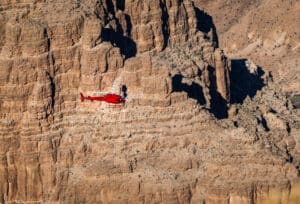
Helicopter flying over Grand Canyon West Rim in Arizona, USA
We ended up dedicating multiple days and still felt it wasn’t enough – there was always another trail beckoning or another overlook we hadn’t seen yet. Our advice: take your time if you can. Sit on a rock and just watch the colors change with the shifting sun. Hike a bit down below the rim to feel the ancient walls towering around you. Stay for a sunset and a sunrise; each paints the canyon in totally different hues. On one evening, we perched at a quiet viewpoint and watched as the sun sank and the cliffs turned fiery orange, then soft pink, then a deep purple twilight. Afterward, the night sky exploded with stars – the Milky Way arched over the canyon, and it was so dark we could see satellites and shooting stars.
We were gonna head back to our lodge early that night, but the celestial show kept us lingering in the chilly darkness, soaking in a scene we’ll never forget. Grand Canyon isn’t the kind of place you rush. Slow down, let it humbly remind you of your place in the timeline of the Earth, and we promise you’ll cherish the experience forever.
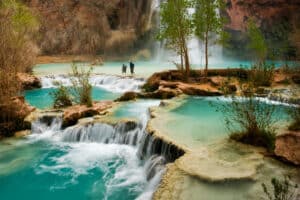
Havasu Falls
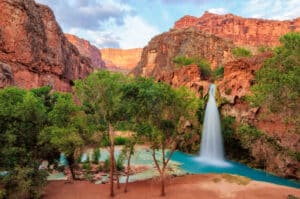
Havasupai Indian Reservation
Local Trails, Activities, and Places to Eat
There’s so many overlooks, side trails, and local treats around the Grand Canyon that we almost felt spoiled for choice. In and around the park, here are some of our favorite discoveries from our trip:
-
Desert View Watchtower: We drove out to Desert View on the canyon’s East Rim and climbed a stone watchtower designed in 1932 by architect Mary Colter. From the top, we enjoyed a jaw-dropping 360° panorama – the Colorado River was visible winding deep in the canyon, and we could even spot the Painted Desert off to the horizon. Inside the tower, Native American-inspired murals adorn the walls, so it’s worth a peek. This spot also had fewer crowds than the village area, and the morning light made every cliff stand out in sharp relief.
-
Bright Angel Trail (into the canyon): As mentioned, this classic trail was a highlight for us. We tackled it in the cool early hours. The trail is well-maintained with rest houses along the way (we refilled our water at the 1.5-Mile Resthouse). Descending into the canyon felt like entering another world – it got hotter and quieter with each step down. We paused often, not just to catch our breath but to marvel at fossils in the rocks and to watch condors circling on the thermals above. Turning around at Indian Garden, we relaxed under the cottonwoods and had a picnic alongside Bright Angel Creek. The climb back up was challenging (take your time, bring plenty of water, and salty snacks), but every switchback gave us a new excuse to stop and gaze at the expanding view behind us. It’s an unforgettable hike that truly immerses you in Grand Canyon’s scale.
-
Hopi Point at Sunset: One evening, we hopped on the free shuttle bus along Hermit Road to reach Hopi Point, which is famed as one of the best sunset viewpoints on the South Rim. The experience did not disappoint. We claimed a spot on the railing and watched the sun dip low, painting the layers of rock in intense oranges and reds. Far below, we could glimpse a sparkly ribbon of the Colorado River catching the last light of day. As the sky turned to twilight, a hush fell over the crowd – it was a moment of pure shared awe. (Insider tip: bring a jacket or sweater, even in summer. Once the sun sets, the temperature dropped quickly and we were glad we had an extra layer.) After darkness fell, the stars came out in force. The shuttle ride back under a sky full of constellations was the perfect cap to our night.
-
Tusayan (Gateway Town): Just outside the park’s South Entrance lies the small town of Tusayan, which became our go-to for food and a little relaxation. After a long hike one afternoon, we were absolutely ravenous and devoured a late lunch at We Cook Pizza & Pasta. Their portions were generous – a loaded supreme pizza piled high with toppings, plus cold sodas, really hit the spot and revived our tired bodies. On another night, we treated ourselves to a hearty dinner at Big E Steakhouse & Saloon. This Western-themed restaurant had a fun ambiance (cowboy decor and even a live music stage). We split a massive T-bone steak with all the fixings, and I’m pretty sure we polished off every bite. The prime rib there was excellent too, perfectly juicy. Sipping a prickly-pear margarita and toasting to our Grand Canyon adventures became a little tradition. There’s nothing like a great meal and a cold beer after trekking around dusty trails all day! Tusayan also has a few cafes (for your caffeine fix and breakfast pastries), an IMAX theater showing a Grand Canyon movie, and some gift shops where we picked up souvenirs. It’s a convenient base to have just minutes from the park gates.
-
Cameron Trading Post (East of the park): On our way out of the park toward Page, we stopped at the historic Cameron Trading Post about 30 minutes east of Desert View. This place has been serving travelers since 1916, and it’s part restaurant, part shop, and part small hotel. We were drawn in by its Old West charm and Navajo artwork. In the dining room, we couldn’t resist trying their famous Navajo Taco – a local specialty that piles seasoned beans, ground meat, cheese, lettuce, and tomato onto fluffy Navajo fry bread. The dish was enormous (one could honestly feed two people) and absolutely delicious, a perfect blend of Southwestern flavors. After eating, we browsed the trading post’s shop, which is like a mini museum. We admired beautiful Navajo rugs, turquoise jewelry, and handcrafted pottery. It was the ideal spot to pick up an authentic keepsake from the region. Walking through the aisles, we felt a sense of the rich cultural heritage connected to the Grand Canyon area – a reminder that this land has been home to Indigenous peoples for generations. We left Cameron with full bellies and a deeper appreciation for the local culture (and yes, a bag of fry bread to-go for later munching!).
-
Havasu Falls (Side Canyon Adventure): Though not located inside the national park boundaries, Havasu Falls is a legendary natural wonder in the Grand Canyon region that we have to mention. Tucked away in a remote side canyon on the Havasupai Indian Reservation, this breathtaking waterfall plunges ~100 feet into striking turquoise-blue pools. A few years ago, one of our friends managed to snag permits and invited us on the challenging hike to Havasu Falls. It’s a 10-mile trek (each way) from the trailhead to the Havasupai village campground, and it certainly tested our endurance – but wow, was it worth it. We spent two nights camping by the falls, falling asleep to the sound of cascading water. By day, we swam in the crystal-clear travertine pools and explored other nearby falls like Mooney Falls (just as stunning, albeit reached by a daring cliffside descent with ladders). The contrast of the tropical-looking blue water against red canyon walls was surreal, like a hidden paradise. Keep in mind you must obtain permits months in advance to visit Havasu Falls, as access is limited and controlled by the Havasupai Tribe. It’s not an easy journey, but if you’re up for an unforgettable side adventure beyond the main park, Havasu Falls is the ultimate bucket-list experience. It showed us a completely different yet profoundly beautiful facet of the Grand Canyon’s broader landscape.
After all these adventures, we felt we had only scratched the surface of Grand Canyon National Park and its surroundings. This place isn’t just a single canyon or a single viewpoint – it’s an ever-unfolding experience with each hike, each lookout, and each conversation with a fellow traveler or ranger. On our last morning, we took one more quiet walk along the rim, watching shadows retreat as the sun climbed higher. We already knew we’d be back. Grand Canyon has a way of humbling you, inspiring you, and calling you to return even before you’ve left. Our journey here was filled with natural wonder, a touch of human history, some tasty meals, and plenty of moments of pure joy. And in the end, as we reluctantly drove away and caught a final glimpse of the canyon in the rearview mirror, one thought stuck with us: the Grand Canyon truly lives up to the hype, and then some. We can’t wait to visit again.
Sorry, there were no items that matched your criteria.

